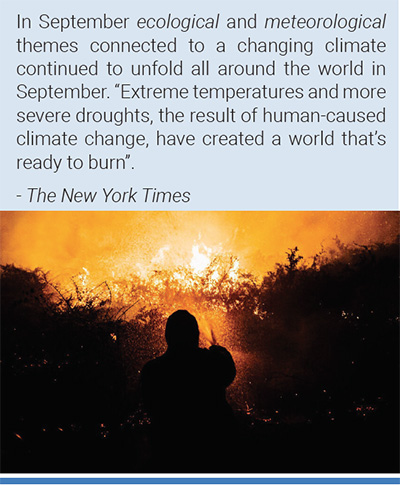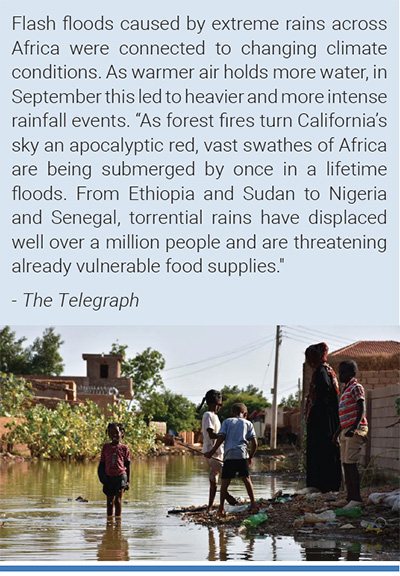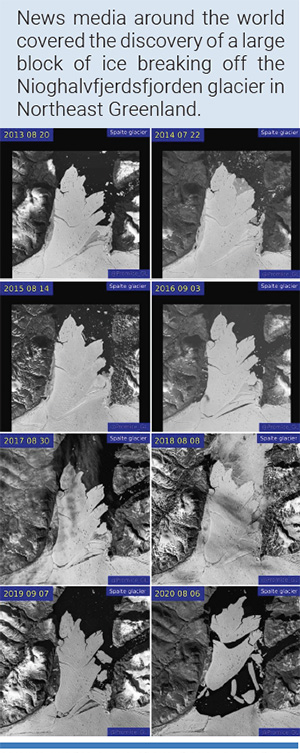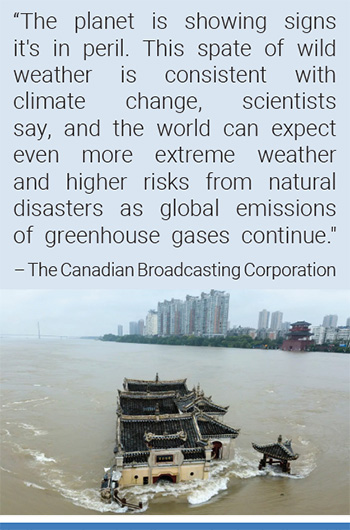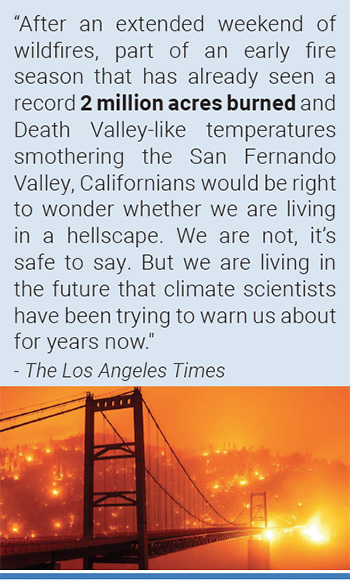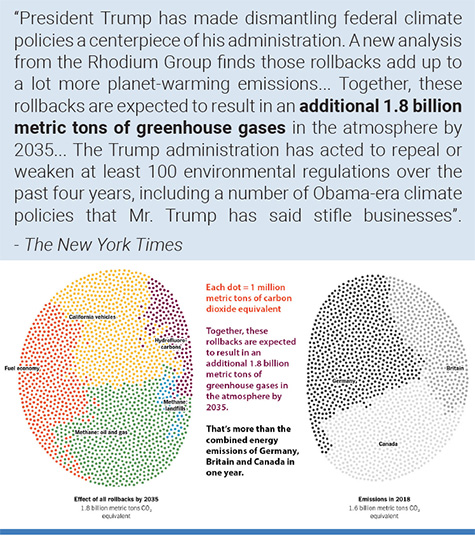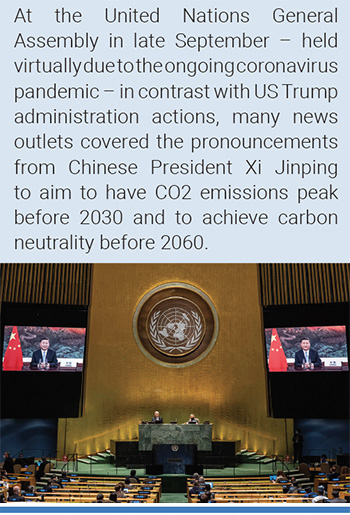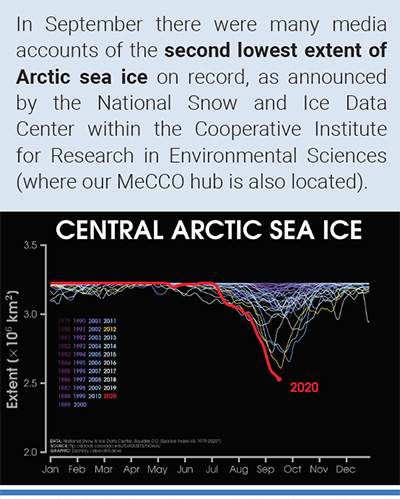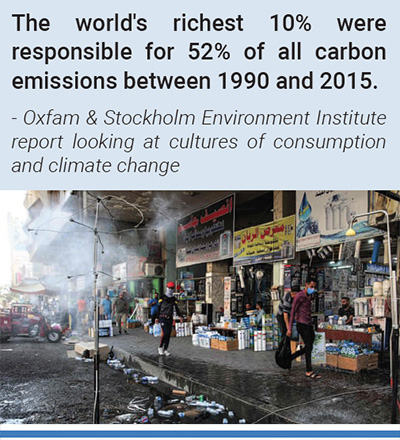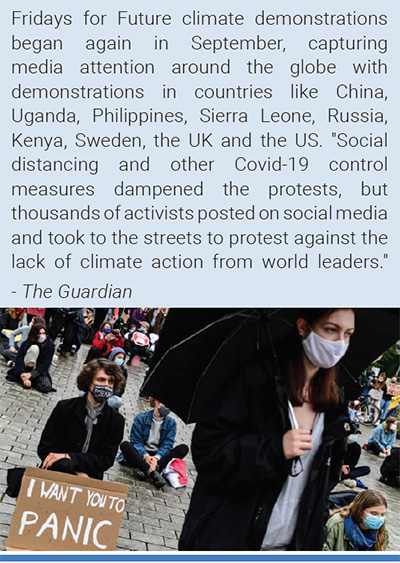Monthly Summaries
Issue 45, September 2020
[DOI]

A satellite image captured on Aug 27, 2020 shows ice breaking off the Nioghalvfjerdsfjorden glacier in Northeast Greenland. Photo: European Space Agency/AFP.
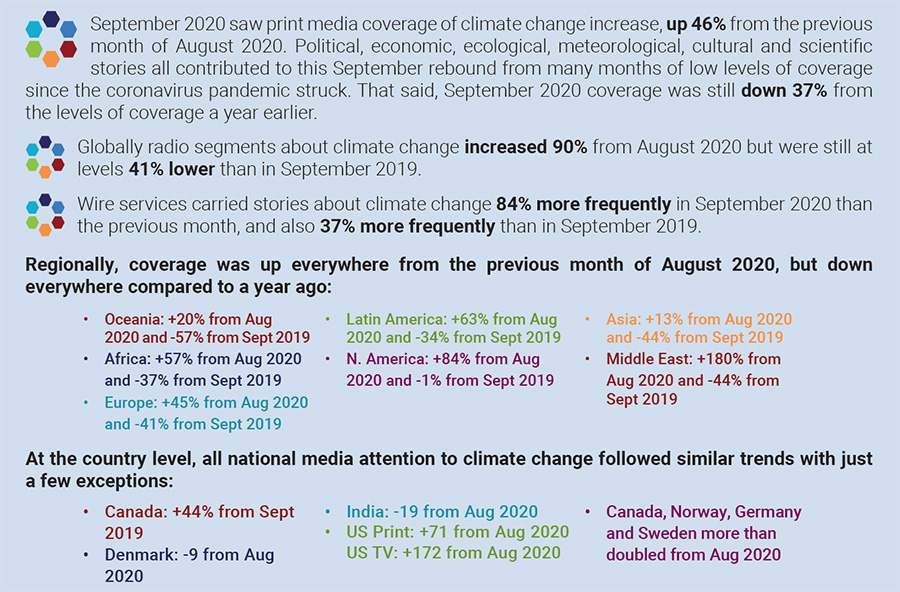
September 2020 saw print media coverage of climate change or global warming increase, up 46% from the previous month of August 2020. Political, economic, ecological, meteorological, cultural and scientific stories all contributed to this September rebound from many months of low levels of coverage since the coronavirus pandemic struck. That said, September 2020 coverage was still down 37% from the levels of coverage a year earlier (September 2019). Figure 1 shows trends in newspaper media coverage at the global scale – organized into seven geographical regions around the world – from January 2004 through September 2020. Globally radio segments about climate change or global warming increased 90% from August 2020 but were still at levels 41% lower than in September 2019. Yet wire services – The Associated Press, Agence France Presse, The Canadian Press and United Press International – carried stories about climate change or global warming 84% more frequently in September 2020 than the previous month, and also 37% more frequently than in September 2019.

Figure 1. Newspaper media coverage of climate change or global warming in print sources in seven different regions around the world, from January 2004 through September 2020.
Regionally, coverage was up everywhere from the previous month of August 2020, but down everywhere compared to a year ago (September 2019). Asian coverage was up 13% from a month ago yet still down 44% from last September. North American coverage rose sharply (84%) from August 2020 yet still was down slightly (1%) from September 2019. Coverage in Oceania increased 20% from last month yet was still down 57% from September 2019. African coverage went up 57% from a month ago but still remained at levels 37% lower than last September. European Union coverage increased 45% from August 2020 but still remained at 41% lower levels than September 2019. Latin American coverage increased 63% from a month ago yet still remained 34% lower than last September. And levels of coverage in the Middle East skyrocketed to levels 180% higher than August 2020, but these levels were nonetheless still down 44% from September 2020.

Figure 2. Swedish newspaper media coverage of climate change or global warming in Dagens Nyheter, Aftonbladet, and Expressen from January 2004 through September 2020.
A volunteer firefighter at work in the Pantanal region of southern Brazil last month. Photo: Maria Magdalena Arrellaga, New York Times. |
At the country level, all national media attention to climate change or global warming followed similar trends with just a few exceptions: Canadian coverage increased 30% in September 2020 from a year ago, while Danish coverage dipped 9% from last month and Indian coverage similarly dropped 19% from August 2020. Otherwise, notable increases in September 2020 coverage from a month ago were detected in the United States (US) television networks – up 172% - and newspapers – up 71%. Moreover, coverage in Canada as well as in Norway more than doubled in September 2020 compared to coverage in August 2020, while coverage in Germany and Sweden nearly doubled from a previous month.
Moving to the content of coverage, in September ecologicaland meteorological themes connected to a changing climate continued to unfold all around the world in September. For example, New York Times journalist Veronica Penney reported on fires in Argentina, Indonesia, The Arctic and Siberia, Australia and Brazil. She wrote, “Extreme temperatures and more severe droughts, the result of human-caused climate change, have created a world that’s ready to burn”.
Figure 3. The front page coverage of the massive block of ice – one sixth the size of Singapore – breaking off the Nioghalvfjerdsfjorden glacier in Northeast Greenland in The Straits Times (Singapore) on September 16, 2020. |
Flash floods caused by extreme rains across West, Central and East Africa in September were also connected to changing climate conditions. As warmer air holds more water, in September this led to heavier and more intense rainfall events in places like Nigeria, Chad, Niger and Cameroon. For example, Africa correspondent Will Brown from The Telegraph reported, “As forest fires turn California’s sky an apocalyptic red, vast swathes of Africa are being submerged by once in a lifetime floods. From Ethiopia and Sudan to Nigeria and Senegal, torrential rains have displaced well over a million people and are threatening already vulnerable food supplies. In Ethiopia, over 500,000 people have been affected after several rivers, including the Blue Nile, broke their banks. Some places recorded the heaviest rains in a century, according to Seleshi Bekele, Ethiopia’s Water and Irrigation Minister. Officials say the floods have killed animals and destroyed homes and crops in a way not seen in decades. About 200,000 people have been left homeless in at least five of Ethiopia's 10 regions, said Mr Bekele. Downriver the devastation in Sudan is immense. Earlier this month, the rains destroyed around 100,000 homes, killing more than 100 people. The river Nile regularly bursts its banks in Sudan, irrigating the area and making parts of the vast nation one of the breadbaskets of Africa. But this year the Nile has reached such an ‘unprecedented level’ that the water is threatening the country’s 200 ancient pyramids”.
From Africa to the Arctic, news media around the world covered the discovery of a large block of ice breaking off the Nioghalvfjerdsfjorden glacier in Northeast Greenland. For example, an Agence France Presse article ran on the front page of The Straits Times in Singapore, noting “A massive chunk of ice - larger than the city of Paris - has broken off from the Arctic's largest ice shelf because of warmer temperatures in Greenland, scientists said...The 113-square-kilometre block, about one-sixth the size of Singapore, broke off the Nioghalvfjerdsfjorden glacier in Northeast Greenland, which the scientists said had been expected given the rising average temperatures...While it is normal for pieces of ice to break off from a glacier - a process called calving - they are generally not this large”. This Straits Times article ran as a front-page story in their September 16 print edition (see Figure 3).
Children play in flood water in Sudan's Omdurman city. Photo: Anadolu Agency. |
Meanwhile – wrapping these regional ecological and meteorological event together in an article entitled ‘Wild weather this year shows growing impact of climate change, scientists say’ – The Canadian Broadcasting Corporation reported, “The planet is showing signs it's in peril. In recent weeks, the world has seen ferocious wildfires in the U.S. West, torrential rains in Africa, weirdly warm temperatures on the surface of tropical oceans, and record heat waves from California to the Siberian Arctic. This spate of wild weather is consistent with climate change, scientists say, and the world can expect even more extreme weather and higher risks from natural disasters as global emissions of greenhouse gases continue...For decades, scientists have warned of such events — but have been wary of saying that a particular storm or heat wave was a direct result of climate change. That's now changing. Advances in a relatively new field known as "event attribution science" have enabled researchers to assess how big a role climate change might have played in a specific case. In determining that link, scientists assess simulations of how weather systems might behave if humans had never started pumping carbon dioxide into the air, and compare that with what is happening today. They also factor in weather observations made over the last century or more”.
In North America, ongoing media coverage of hurricanes in the Caribbean basin garnered significant media attention. For example, Associated Press reporters Stacey Plaisance and Janet McConnaughey noted, “The extraordinarily busy hurricane season — like the catastrophic wildfire season on the West Coast — has focused attention on the role of climate change. Scientists say global warming is making the strongest of hurricanes, those with wind speeds of 110 mph or more, even stronger. Also, warmer air holds more moisture, making storms rainier, and rising seas from global warming make storm surges higher and more damaging. In addition, scientists have been seeing tropical storms and hurricanes slow down once they hit the United States by about 17% since 1900, and that gives them the opportunity to unload more rain over one place, as 2017’s Hurricane Harvey did in Houston”.
Satellite images of the Spalte glacier disintegration between 2013 and 2020. Photo: Reuters. |
Hurricanes that ran through the English alphabet and into the Greek alphabet prompted media accounts that connected these events to a changing climate. For example, CNN journalists Jason Hanna and Hollie Silverman reported, “A Category 1 Hurricane Sally is pummeling southern Alabama and the Florida Panhandle after it crossed land Wednesday morning, prompting water rescues, sapping power, dropping trees and threatening catastrophic flooding as it crawls at an agonizingly slow pace”. Meanwhile, Associated Press journalists Jay Reeves, Angie Wang and Jeff Martin noted, “Like the wildfires raging on the West Coast, the onslaught of hurricanes has focused attention on climate change, which scientists say is causing slower, rainier, more powerful and more destructive storms”.
And as The Associated Press article mentioned, not just hurricane activity garnered media attention in September, but also wildfires across the western US generated media connections with climate change and global warming. For instance, a Los Angeles Times Editorial commented, “After an extended weekend of wildfires, part of an early fire season that has already seen a record 2 million acres burned and Death Valley-like temperatures smothering the San Fernando Valley, Californians would be right to wonder whether we are living in a hellscape. We are not, it’s safe to say. But we are living in the future that climate scientists have been trying to warn us about for years now. No, climate change did not start the El Dorado fire Saturday near Yucaipa. That, authorities report, was caused by celebrants setting off some pyrotechnics during a gender-reveal party. (What the hell were they thinking?) And climate change did not spark the Bobcat fire the next day in the San Gabriel Mountains north of Monrovia. But climate change has played a role in the conditions — in particular, the drier, hotter air and deeper droughts creating more flammable ecosystems — that are making these fires bigger and more dangerous. The fires here are part of a broad burning of wildlands in the West, which occurred naturally before densifying human settlements and the non-native plants they introduced began changing the balance of nature. The Insurance Information Institute counted almost 40,000 wildfires in the country this year through Aug. 31, compared with fewer than 33,600 for the same time frame in 2019...This is the kind of change that climate experts told us to expect. But there is more going on than the smoke in our skies”.
Figure 4. Front page coverage USA Today, The New York Times, and The Los Angeles Times in mid-September documenting these intersections of ecological and political themes of climate change. |
These stories of wildfires then spilled into political and economic media coverage of climate change or global warming in September. For example, as US President Donald J. Trump traveled to California to inspect the fire damage and espouse outlier perspectives regarding wildfire activity and a changing climate, his US Democratic challenger Joe Biden attacked the President for his inaction as well as misinformation about climate change. For example, journalists Seung Min Kim and Brady Dennis from The Washington Post noted, “Democratic presidential nominee Joe Biden excoriated President Trump on Monday over his environmental record as wildfires continued to burn through much of the West and as the president used a trip to California to question the scientific consensus that climate change is a leading cause of the devastating blazes”. As another example, PBS Newshour journalist Lisa Desjardins reported, “The wildfire disaster in the American West is highlighting a major political difference between President Trump and Joe Biden: their perspectives on climate change. While scientists increasingly warn that climate change is driving extreme weather events like the western fires -- a view Biden adopts -- Trump blames the phenomenon on poor forest management”. Figure 4 shows the front pages of USA Today, Los Angeles Times and The New York Times in mid-September documenting these intersections of ecological and political themes of climate change.
The Kwanyin temple built on a rocky island in the middle of the Yangtze River is seen flooded along Ezhou in central China's Hubei province. The temple first built in 1345AD has survived numerous floods and been rebuilt over the centuries. Photo: Chinatopix via AP. |
As another illustration, in an article titled ‘Underwater and on fire: US climate change magnifies extremes’, Associated Press journalist Seth Borenstein noted, “America’s worsening climate change problem is as polarized as its politics. Some parts of the country have been burning this month while others were underwater in extreme weather disasters. The already parched West is getting drier and suffering deadly wildfires because of it, while the much wetter East keeps getting drenched in mega-rainfall events, some hurricane related and others not. Climate change is magnifying both extremes, but it may not be the only factor, several scientists told The Associated Press”.
Further into political and economic themes in September media coverage of climate change or global warming, media portrayed actions from the US Trump administration regarding the climate implications of various environmental rollbacks. For example, New York Times journalists Nadja Popovich and Brad Plumer wrote, “President Trump has made dismantling federal climate policies a centerpiece of his administration. A new analysis from the Rhodium Group finds those rollbacks add up to a lot more planet-warming emissions...Together, these rollbacks are expected to result in an additional 1.8 billion metric tons of greenhouse gases in the atmosphere by 2035... The Trump administration has acted to repeal or weaken at least 100 environmental regulations over the past four years, including a number of Obama-era climate policies that Mr. Trump has said stifle businesses”.
Also in September, General Electric announced that it will no longer build coal-fired power plants, in a shift to a focus on renewable energy in the context of a changing climate. BBC reported, “In a dramatic reversal, one of the world's biggest makers of coal-fired power plants is to exit the market and focus on greener alternatives. US industrial giant General Electric said it would shut or sell sites as it prioritised its renewable energy and power generation businesses. It comes ahead of a US Presidential election in which the candidates hold starkly different views on coal... GE has said in the past it would focus less on fossil fuels, reflecting the growing acceptance of cleaner energy sources in US power grids”. Meanwhile, journalist Matt Egan at CNN noted, “Struggling GE (GE) announced Monday it won't build new coal-fueled power plants, making it the latest major company to dump coal in an exit that may include asset sales, site closures and layoffs. The move marks a dramatic reversal for GE. Just five years ago, the company doubled down on coal by acquiring Alstom's power business, which makes coal-fueled turbines. That $9.5 billion deal -- GE's biggest-ever industrial purchase -- proved to be a disaster. Coal has been crushed by the rise of natural gas and a shift toward solar, wind and renewable energy. Since then, GE has laid off thousands of power workers, slashed its dividend to a penny, fired two CEOs and sharply written down the value of its power business”.
Fires light up a hillside behind the Bidwell Bar Bridge in Oroville, California. Photo: Noah Berger, AP. |
And at the United Nations General Assembly in late September – held virtually due to the ongoing coronavirus pandemic – in contrast with US Trump administration actions, many news outlets covered the pronouncements from Chinese President Xi Jinping to aim to have CO2 emissions peak before 2030 and to achieve carbon neutrality before 2060. For example, New York Times journalist Somini Sengupta reported, “President Xi Jinping of China pledged on Tuesday that his country would adopt much stronger climate targets and achieve what he called “carbon neutrality before 2060.” If realized, the pledges would be crucial in the global fight against climate change. The announcement, made at the annual meeting of the United Nations General Assembly, is significant because China is currently the top producer of greenhouse gas emissions. What the country does to curb its emissions, therefore, is crucial to slowing down global warming on the whole”.
Furthermore, the virtual United Nations General Assembly and virtual Climate Week NYC generated additional media attention. For instance, Washington Post correspondents Stephen Mufson and Brady Dennis reported, “Fall in New York typically means environmental groups, international corporations, government leaders and U.N. officials flocking to the Big Apple for Climate Week. Last year, they promised more meaningful action to tackle climate change — and hundreds of thousands of young people took to the streets to demand it. This year’s event looks starkly different. The coronavirus pandemic, the reeling economy and the looming U.S. election have commandeered the nation’s attention and forced Climate Week, like so much else in modern life, to migrate online. Yet some of the world’s biggest companies say they have not lost sight of the urgency of climate change and have announced new plans to combat it. Morgan Stanley, AT&T and Walmart made fresh commitments and adopted more aggressive timetables for reducing greenhouse gas emissions. At the same time, General Electric announced that it will no longer build new coal-fired power plants”.
Sources: The New York Times and The Rhodium Group; country comparisons via the International Energy Agency. |
Also, scientific findings and reports of record-breaking warmth in the Northern Hemisphere captured media attention. For example, Guardian journalist Emily Holden reported, “This summer was the hottest ever recorded in the northern hemisphere, according to US government scientists. June, July and August were 1.17C (2.11F) above the 20th-century average, according to the National Oceanic and Atmospheric Administration (NOAA). The new record surpassed the summers of 2016 and 2019. Last month was also the second-hottest August ever recorded for the globe. The numbers put 2020 on track to be one of the five warmest years, according to NOAA. United Nations officials have warned that many countries are not prepared to advance climate ambitions, while the US faces a presidential election that will decide whether it will contribute to such global efforts or hinder them. With aggressive federal action, the US could cut its climate pollution almost in half by 2030 compared with 2005, according to the latest report from America’s Pledge, a group of private- and public-sector leaders. Even if Donald Trump wins re-election and largely ignores climate change, states, cities and businesses could still cut emissions by 37% by 2030, the report finds. The climate crisis is increasingly moving into the spotlight in the US presidential race. The Democratic nominee, Joe Biden, on Monday aggressively targeted Trump in remarks connecting historic wildfires in the western US to human-made climate change”.
Also, in September there were many media accounts of the second lowest extent of Arctic sea ice on record, as announced by the National Snow and Ice Data Center (NSIDC) within the Cooperative Institute for Research in Environmental Sciences (CIRES) (where our MeCCO hub is also located). For example, USA Today correspondent Doyle Rice wrote, “Fueled by unusual warmth at the top of the world, Arctic sea ice shrank to its second-lowest level on record... Arctic sea ice typically reaches its smallest extent in September and largest in March. The minimum was reached on Sept. 15 and measured 1.44 million square miles. This is about 958,000 square miles below average, according to a statement from NASA. This appears to be the lowest extent of the year, the National Snow and Ice Data Center said. In response to the setting sun and falling temperatures, ice extent will begin increasing through autumn and winter. However, a shift in wind patterns or a period of late-season melt could still push the ice extent lower. This year ranks behind only 2012, when the lowest level on record was measured. Arctic sea ice has been measured since 1979. The amount of summer sea ice in the Arctic has been steadily shrinking over the past few decades because of man-made global warming, according to the National Oceanic and Atmospheric Administration and NASA.”
President Xi Jinping of China addressed the United Nations General Assembly in New York via video in September. Photo: United Nations via Reuters. |
Last, cultural themes continued to weave through many climate change or global warming stories in September. Several of these cultural stories also threaded through ecological and meteorological accounts described earlier. For example, journalist Jessica Guynn from USA Today wrote, “Facebook says it’s moving aggressively to counter climate-change misinformation with a Climate Science Information Center that launched Tuesday and aims to connect users with science-based facts. “Climate change is real," the company said. "The science is unambiguous and the need to act grows more urgent by the day." The announcement comes just days after emergency responders in the Pacific Northwest had to fight misinformation on Facebook along with catastrophic wildfires, and ahead of Climate Week, a conference run by international nonprofit the Climate Group, in association with the United Nations and the city of New York…the success of Facebook's COVID-19 Information Center which has directed more than 2 billion people to information from health authorities shows that the company has not been limited by technology but by a lack of will, according to John Cook, a research assistant professor at the Center for Climate Change Communication at George Mason University”. Moreover, NBC News reporter Dylan Byers observed, “Facebook announced Tuesday that it is launching a science information center to provide users with facts and resources around the climate crisis. The new feature is the latest in a string of resource hubs that have enabled Facebook to set clear lines of demarcation on matters of fact and fiction. But Facebook will not change its approach to combating climate misinformation outside the hub. It will continue to apply warning labels to demonstrably false information, but will not take down posts unless they pose an immediate safety risk”.
Graphic: Zachary Labe. Source: https://nsidc.org/arcticseaicenews/charctic-interactive-sea-ice-graph. |
As another cultural example, amid mounting experiential and scientific evidence of a changing climate, New York Times journalists Michael M. Grynbaum and Tiffany Hsu reported on ongoing conservative media and Trump Administration resistance to indications of climate change. In a piece entitled ‘‘Nothing to Do With Climate Change’: Conservative Media and Trump Align on Fires’, Grynbaum and Hsu wrote, “Rush Limbaugh told millions of his radio listeners to set aside any suggestion that climate change was the culprit for the frightening spate of wildfires ravaging California and the Pacific Northwest. “Man-made global warming is not a scientific certainty; it cannot be proven, nor has it ever been,” Mr. Limbaugh declared on his Friday show, disregarding the mountains of empirical evidence to the contrary. He then pivoted to a popular right-wing talking point: that policies meant to curtail climate change are, in fact, an assault on freedom. “Environmentalist wackos” — Mr. Limbaugh’s phrase — “want man to be responsible for it because they want to control your behavior,” the conservative host said on the show. He added that they “want to convince you that your lifestyle choices are the reason why all these fires are firing up out on the Left Coast.” Hours later, that message leapt to prime time on Fox News, where the host Tucker Carlson said those who blamed climate change for the fires were merely reciting “a partisan talking point.”... “In the hands of Democratic politicians, climate change is like systemic racism in the sky,” Mr. Carlson told viewers. “You can’t see it, but rest assured, it’s everywhere, and it’s deadly. And like systemic racism, it is your fault.” Mr. Limbaugh and Mr. Carlson are two of the most prominent commentators in the right-wing media sphere, where a rich history of climate denialism has merged with Trump-era cultural warfare to generate a deep skepticism of the notion that climate change is a factor in the fires devastating the West Coast. Like President Trump, conservative media stars dismiss climate change — which scientists say is the primary cause of the conflagration — and point to the poor management of forestland by local (and, conveniently, Democratic) officials. Fringe right-wing websites, like The Gateway Pundit, have blamed left-wing arsonists, fueling false rumors that authorities say are impeding rescue efforts. Visiting California on Monday to witness the destruction firsthand, Mr. Trump took Western states to task for failing to manage the forests properly. During a meeting with California officials who pushed him to acknowledge the role of climate change in the wildfires, the president said: “It’ll start getting cooler. You just watch.””
Sprinklers in the street in Baghdad, Iraq, where temperatures reached 51C in July. Photo: Ahmad Al-Rubaye/AFP/Getty Images. |
Also, an Oxfam and Stockholm Environment Institute report looking at cultures of consumption and climate change effects garnered media attention in September. Among their findings, they noted that world's richest 10% were responsible for 52% of all carbon emissions between 1990 and 2015. The report generated abundant media attention. For example, Guardian environment correspondent Fiona Harvey reported, “The wealthiest 1% of the world’s population were responsible for the emission of more than twice as much carbon dioxide as the poorer half of the world from 1990 to 2015, according to new research. Carbon dioxide emissions rose by 60% over the 25-year period, but the increase in emissions from the richest 1% was three times greater than the increase in emissions from the poorest half. The report, compiled by Oxfam and the Stockholm Environment Institute, warned that rampant overconsumption and the rich world’s addiction to high-carbon transport are exhausting the world’s “carbon budget”. Such a concentration of carbon emissions in the hands of the rich means that despite taking the world to the brink of climate catastrophe, through burning fossil fuels, we have still failed to improve the lives of billions, said Tim Gore, head of policy, advocacy and research at Oxfam International”.
Supporters of the school strike movement Fridays for Future gather in Berlin, Germany, on September 25. Photo: Filip Singer/EPA. |
Also, Fridays for Future climate demonstrations began again in September, capturing media attention around the globe with demonstrations in countries like China, Uganda, Philippines, Sierra Leone, Russia, Kenya, Sweden, the UK and the US. For example, Guardian journalist Fiona Harvey reported, “School pupils, youth activists and communities around the world have turned out for a day of climate strikes, intended to underscore the urgency of the climate crisis even in the midst of the coronavirus pandemic. Social distancing and other Covid-19 control measures dampened the protests, but thousands of activists posted on social media and took to the streets to protest against the lack of climate action from world leaders. Strikes were scheduled in at least 3,500 locations around the globe. Friday’s strikes – some in the form of mostly socially distanced physical marches on the streets, and some purely online meetings – were on a smaller scale and far more subdued than last year’s September week of action, in which at least 6 million people around the world were estimated to have taken part”.
We in the Media and Climate Change Observatory (MeCCO) are here for you, as we remain committed to our work monitoring media coverage of these intersecting dimensions and themes associated with climate change in this year 2020. That said, our ongoing work is dependent on financial support so please consider contributing here.

